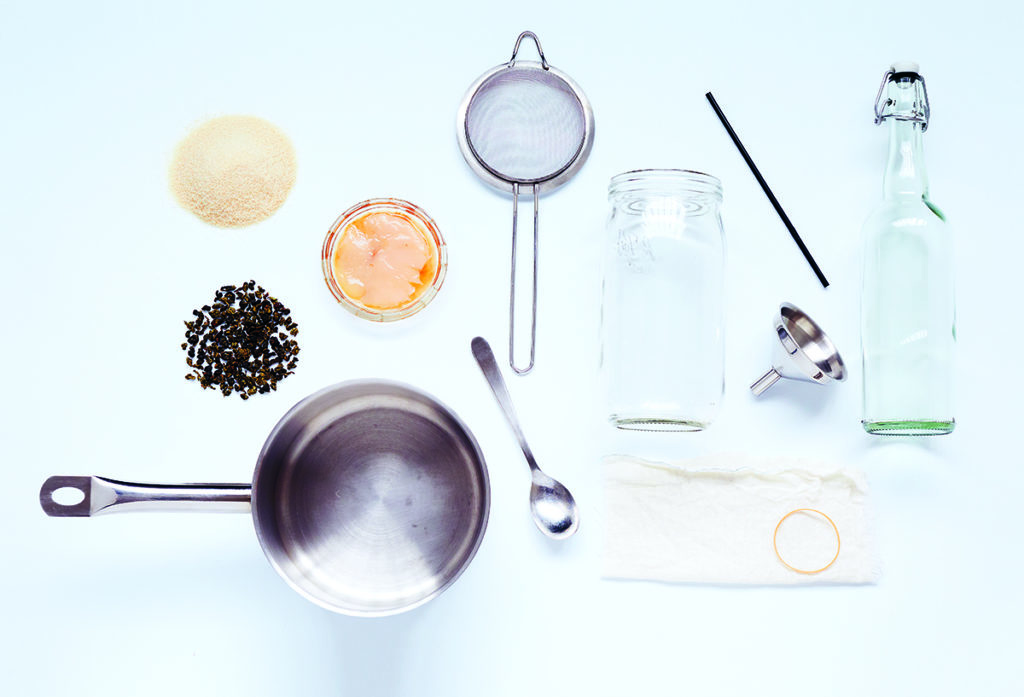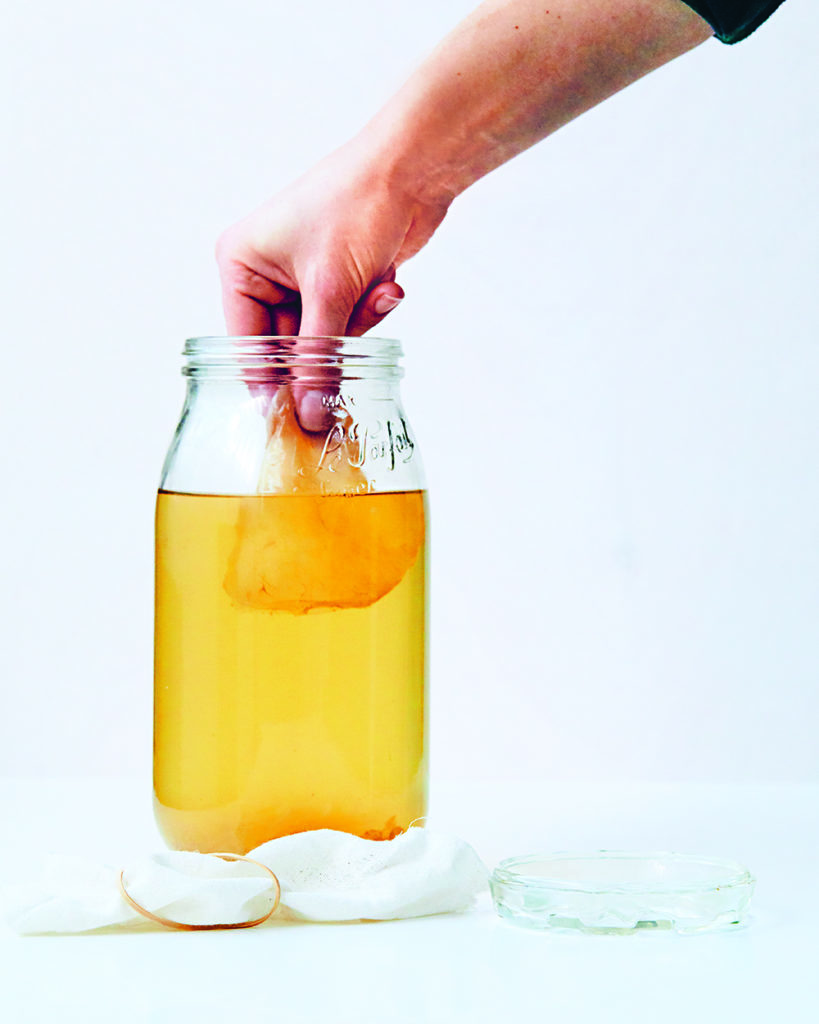Not only is the fresh, zingy taste of kombucha delicious, its a natural probiotic that supports gut health – and it’s easy to make at home.
Kombucha is a fermented drink made from tea which has become very popular over the last few years. The origins of kombucha aren’t clear: the first cultures are thought to have been grown in Tibet or Mongolia. Drinking kombucha became a custom in China, where it was known for its health-giving properties: at the time of the Qin dynasty (220 BC) it was called ‘longevity mushroom’.
What is it? A naturally fizzy drink made from tea.
What does it taste like? Like cider with a slightly tart edge.
What is the fermenting agent? Exogenous, kombucha starter/mother/scoby.
Ingredients (Makes 1.5 litres)
- 1.5 litres (51 fl oz) bottled spring water
- 8 g (¼ oz) tea leaves, either green (sencha or oolong), black or white
- 90 g (3¼ oz) organic sugar
- 150 ml (5 fl oz) starter tea
- 1 kombucha mother (or scoby)
Equipment
- 1 stainless steel saucepan or 1 kettle
- 1 stainless steel spoon
- 1 × 1.8–2 litre (60¾–68 fl oz)
- Le Parfait-style jar (without lid)
- 1 clean piece breathable fabric such as cheesecloth or linen
- 1 rubber band
- 1 straw
- 1 stainless steel sieve
- 1 small funnel
- 1 × 1 litre (34 fl oz) airtight screwcap or flip-top bottle for second fermentation

Preparation (30 minutes)
Bring the water to a gentle simmer (don’t let it boil), then remove the pan from the heat, stir in the tea leaves and set aside to infuse
for 5–10 minutes, depending on the type of tea (black tea needs more time to steep).
Stir in the sugar until dissolved, then set the mixture aside to cool completely. It’s very important to ensure the liquid is at room temperature before you add the culture, otherwise, you’ll kill the microorganisms!
Transfer the mixture to the jar, then add the starter tea and the kombucha mother. Cover with the cheesecloth and secure with the rubber band.
Fermentation (7–14 days)
Set the jar aside to ferment in a warm place (22–26°C/72–79°F) for 7–14 days, away from direct sunlight (see ‘Fermenting tips’, below).
Taste regularly using the straw: the longer you leave the kombucha to ferment, the more vinegary it will taste. If the fermentation is going well, you should see a new kombucha mother forming on the surface of the liquid after 5–7 days.
If this doesn’t happen, or only mould forms on the surface, throw the kombucha away and start again.
Harvesting (10 minutes)
When your kombucha is ready, remove the kombucha mother, and reserve one-tenth of your kombucha to use as the starter tea in your next brew. Strain the remaining kombucha into the bottle by suspending the sieve over the funnel; seal the bottle tightly.
The kombucha is ready to drink at this stage; either chill it in the refrigerator or conduct a second fermentation to make the finished
drink more fizzy.
Second fermentation (2–3 days)
Leave the bottle at room temperature for 2–3 days, then chill for at least 24 hours before serving. Serve cold.
How will I know if it hasn’t worked? The drink will still taste like tea, it will be very sweet with no tartness, and have foamy white, green or black mould on its surface.
When is it ready to drink? When it tastes almost like cider, is a little tart and smells faintly of vinegar.
Fermenting tips
Start tasting from the first few hours of fermentation onwards; this will help you to educate your palate and be able to choose your preferred level of fermentation.
The duration of each fermentation depends mainly on the heat applied to the mixture and the size of the jar. Fermenting your kombucha for a longer period at a lower temperature will make its flavours more delicate.
Here are the stages of fermentation: it will change from a sweet tea (1–3 days), to something that tastes like cider (4–10 days),
before finally acquiring a less sweet, more vinegary taste (10 days).
Sparkling tips
If you’re fermenting more than one drink at a time (whether kefir, kombucha or something else), keep them separate
to avoid contamination.
If you can’t seem to get any bubbles into your kombucha, it’s because there isn’t enough yeast in there. Before you
bottle the contents of your fermenting jar, mix the dregs at the bottom of the jar thoroughly into the fermented liquid.
This is an extract from Kombucha, Kefir & Natural Sodas by Nina Lausecker & Sebastian Landaeus (Simon & Schuster). RRP $35.00 Out Now.












